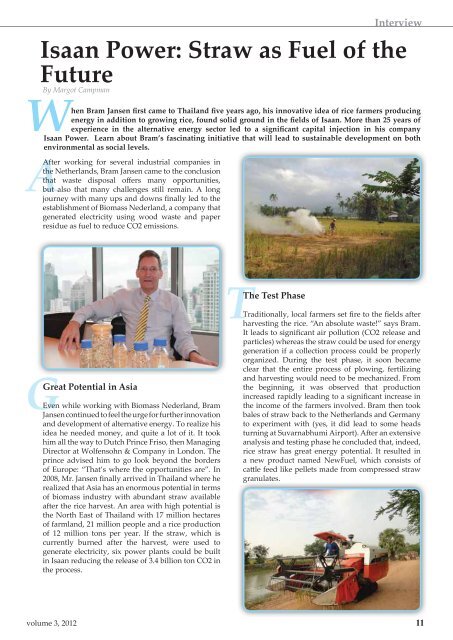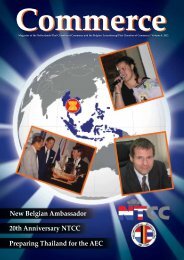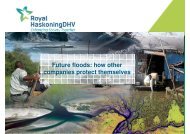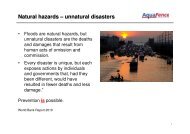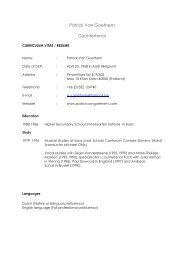Back Cocktail Isaan Power - the Netherlands - Thai Chamber of ...
Back Cocktail Isaan Power - the Netherlands - Thai Chamber of ...
Back Cocktail Isaan Power - the Netherlands - Thai Chamber of ...
You also want an ePaper? Increase the reach of your titles
YUMPU automatically turns print PDFs into web optimized ePapers that Google loves.
Interview<br />
<strong>Isaan</strong> <strong>Power</strong>: Straw as Fuel <strong>of</strong> <strong>the</strong><br />
Future<br />
By Margot Campman<br />
W<br />
hen Bram Jansen fi rst came to <strong>Thai</strong>land fi ve years ago, his innovative idea <strong>of</strong> rice farmers producing<br />
energy in addition to growing rice, found solid ground in <strong>the</strong> fi elds <strong>of</strong> <strong>Isaan</strong>. More than 25 years <strong>of</strong><br />
experience in <strong>the</strong> alternative energy sector led to a signifi cant capital injection in his company<br />
<strong>Isaan</strong> <strong>Power</strong>. Learn about Bram’s fascinating initiative that will lead to sustainable development on both<br />
environmental as social levels.<br />
A<br />
After working for several industrial companies in<br />
<strong>the</strong> Ne<strong>the</strong>rlands, Bram Jansen came to <strong>the</strong> conclusion<br />
that waste disposal <strong>of</strong>f ers many opportunities,<br />
but also that many challenges still remain. A long<br />
journey with many ups and downs fi nally led to <strong>the</strong><br />
establishment <strong>of</strong> Biomass Nederland, a company that<br />
generated electricity using wood waste and paper<br />
residue as fuel to reduce CO2 emissions.<br />
GGreat Potential in Asia<br />
Even while working with Biomass Nederland, Bram<br />
Jansen continued to feel <strong>the</strong> urge for fur<strong>the</strong>r innovation<br />
and development <strong>of</strong> alternative energy. To realize his<br />
idea he needed money, and quite a lot <strong>of</strong> it. It took<br />
him all <strong>the</strong> way to Dutch Prince Friso, <strong>the</strong>n Managing<br />
Director at Wolfensohn & Company in London. The<br />
prince advised him to go look beyond <strong>the</strong> borders<br />
<strong>of</strong> Europe: “That’s where <strong>the</strong> opportunities are”. In<br />
2008, Mr. Jansen fi nally arrived in <strong>Thai</strong>land where he<br />
realized that Asia has an enormous potential in terms<br />
<strong>of</strong> biomass industry with abundant straw available<br />
after <strong>the</strong> rice harvest. An area with high potential is<br />
<strong>the</strong> North East <strong>of</strong> <strong>Thai</strong>land with 17 million hectares<br />
<strong>of</strong> farmland, 21 million people and a rice production<br />
<strong>of</strong> 12 million tons per year. If <strong>the</strong> straw, which is<br />
currently burned after <strong>the</strong> harvest, were used to<br />
generate electricity, six power plants could be built<br />
in <strong>Isaan</strong> reducing <strong>the</strong> release <strong>of</strong> 3.4 billion ton CO2 in<br />
<strong>the</strong> process.<br />
TThe Test Phase<br />
Traditionally, local farmers set fi re to <strong>the</strong> fi elds after<br />
harvesting <strong>the</strong> rice. “An absolute waste!” says Bram.<br />
It leads to signifi cant air pollution (CO2 release and<br />
particles) whereas <strong>the</strong> straw could be used for energy<br />
generation if a collection process could be properly<br />
organized. During <strong>the</strong> test phase, it soon became<br />
clear that <strong>the</strong> entire process <strong>of</strong> plowing, fertilizing<br />
and harvesting would need to be mechanized. From<br />
<strong>the</strong> beginning, it was observed that production<br />
increased rapidly leading to a signifi cant increase in<br />
<strong>the</strong> income <strong>of</strong> <strong>the</strong> farmers involved. Bram <strong>the</strong>n took<br />
bales <strong>of</strong> straw back to <strong>the</strong> Ne<strong>the</strong>rlands and Germany<br />
to experiment with (yes, it did lead to some heads<br />
turning at Suvarnabhumi Airport). After an extensive<br />
analysis and testing phase he concluded that, indeed,<br />
rice straw has great energy potential. It resulted in<br />
a new product named NewFuel, which consists <strong>of</strong><br />
catt le feed like pellets made from compressed straw<br />
granulates. g<br />
volume 3, 2012 11


